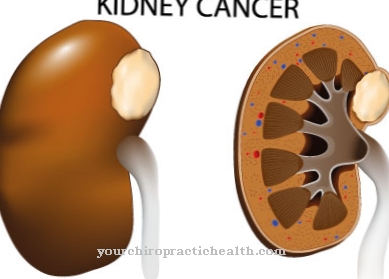Under one chronic sinusitis One understands in the medical jargon a permanent sinus infection. It is caused by an infection of the nose with viruses or bacteria and can be treated with various drugs.
What is Chronic Sinusitis?

© p6m5 - stock.adobe.com
Chronic sinusitis is an inflammation of the mucous membrane in the paranasal sinuses, which does not go away completely. One speaks of a chronic illness when the symptoms persist after two to three months.
The disease occurs relatively frequently and in its acute form mostly affects the maxillary sinus and ethmoid bone. Chronic sinusitis also occurs in these areas, but it can spread further.
causes
Chronic sinusitis occurs as a result of an acute sinus infection. This in turn is triggered by an inadequately treated cold or a sore throat.
If there is no timely response, the symptoms will become chronic. Certain allergies to pollen, house dust or other foreign bodies can also trigger the disease. However, chronic sinusitis can also be cured with appropriate measures.
The cause of chronic sinus inflammation can also be anatomical. A bent nasal septum, enlarged turbinates or nasal polyps have a particularly negative effect on the course of the disease.
Symptoms, ailments & signs
Chronic sinus infection can cause a number of symptoms. Typical of the disease are recurring colds, which are accompanied by runny nose, headache, stuffy nose and other classic symptoms and complaints. Usually there is a discharge that is yellow-greenish, purulent and tough.
It drains out of the nose and down the throat, closing the nasal cavities. This leads to poor nasal breathing, which can cause dizziness, a drop in performance and a great deal of malaise. As a rule, the perception of smell and taste is also reduced.The patient usually also feels a feeling of congestion in the face, which increases in intensity as the disease progresses.
The facial pain is usually stabbing, piercing, or pulsating. They occur more often over the forehead, nose or cheek and often radiate into the middle of the skull or into the area between the eyes. It is typical of the disease that the pain intensifies when the person concerned bends over quickly, stands up or hops on one leg. Chronic sinusitis can be confined to a single sinus, but it can also affect the entire nasopharynx. It is often accompanied by a fever or polyp formation.
Diagnosis & course
In order to be able to diagnose chronic sinusitis, the acute underlying disease must first be clearly identified as such. This is done on the basis of the typical symptoms of a sinus infection. These include pain in the forehead or upper jaw area, purulent runny nose, problems with the sense of smell and a blocked nose.
If these symptoms are not present, sinusitis can usually be ruled out. In the case of chronic sinusitis, however, the diagnosis is more difficult because the symptoms are much weaker and only occur in spurts.
If the likelihood of sinusitis is high, an endoscopic examination is usually done to confirm the diagnosis. The endoscope is inserted into the mouth and nostrils in order to detect emerging secretions and swellings. The secretions are also examined in order to be able to detect the causative agent of sinusitis. The appropriate medication is then prescribed. Chronic sinusitis is only diagnosed when various preparations fail.
In addition, further examinations such as computed tomography and various allergy tests are carried out so that an operation is possible. In addition, dental checks and smell tests can be useful in order to avoid concomitant diseases. The disease is usually not fatal for those affected, but it severely restricts the quality of life and sometimes causes major problems in everyday life.
Complications
One speaks of chronic sinusitis if the inflammation has not cured even after two to three months. After that, there is still the possibility that the disease will resolve on its own, but further steps are taken to prevent it from spreading. With medication and a change in external circumstances, chronic sinus infections can be made more comfortable for those affected.
However, it cannot always be completely cured and some patients have to take medication against it for life. Chronic sinusitis can spread, spread to neighboring body regions and damage them. If no medical treatment is given, serious complications can arise.
The eyes in particular are particularly at risk. The sinuses and eyes are separated by a thin plate of bone. Inflammation can damage it so much that a breakthrough occurs and bacteria can get directly into the eye socket. Serious eye damage or even blindness can be the result.
The brain is also considered to be at risk from chronic sinusitis. If the bony separation between the brain and paranasal sinuses breaks through, meningitis (meningitis) may result. This can pose a life-threatening threat and requires urgent medical treatment. There is also the risk that pus will settle in the brain structures and abscesses will develop. It is also possible that blood clots form in the brain veins (thrombosis).
There is also the risk of encroachment on the teeth. It is not uncommon for tooth root inflammation to have its origin in chronic sinusitis. If left untreated, breathing through the nose deteriorates more and more. A consequential problem is snoring.
When should you go to the doctor?
A chronification of the simple sinus infection should be seen as a complication. For this reason, any chronic sinusitis requires medical treatment. Serious complications can only be avoided if a doctor is consulted in good time.
In advanced stages, surgical therapy is usually unavoidable. Otherwise the symptoms will not improve. If major surgery is to be avoided, it makes sense to consult a doctor as early as possible. As a rule, a doctor should be consulted if the symptoms of the acute sinusitis persist beyond the usual period. In this case the doctor can intervene - often by giving an antibiotic.
A significant improvement in the stressful problem can usually be achieved just a few weeks after visiting a doctor. In this case, the right contact person is the specialist in ear, nose and throat medicine, who has a wide range of diagnostic and therapeutic options available. This specialist doctor can also be consulted without a referral from the family doctor.
Doctors & therapists in your area
Treatment & Therapy
After chronic sinusitis is diagnosed, various measures can be initiated. If allergies are the cause, antiallergic drugs and nasal sprays are prescribed. So-called desensitization is also part of some therapies. Antibiotics and nasal rinses are also prescribed to flush out bacteria and relieve the symptoms.
In some cases, a change in diet can help against chronic sinusitis. This is the case when there is a food intolerance. In either case, an expert must be consulted to effectively treat the condition. In addition to lengthy therapies, there is now also the option of resolving the symptoms surgically. The closed connecting ducts are expanded with the help of a balloon. This so-called siluplasty is only suitable for simple cases of chronic sinusitis.
Treatment methods used for acute sinusitis can at least alleviate the symptoms in the chronic form. Common therapies include inhaling steam, acupuncture, and the use of essential oils.
Outlook & forecast
The prognosis of chronic sinusitis is individual and cannot be predicted uniformly for all affected persons. In a large number of patients, despite the chronic course of the disease, healing and complete freedom from symptoms occur.
There is also the possibility of a continuous course of the disease in which the patient has lifelong impairments. If the doctors can restore the sinus ventilation, there is a good chance of recovery. Surgical intervention tries to achieve this goal. The success depends on the severity of the disease, the age of the patient and their general health.
By restoring the ventilation of the paranasal sinuses, the functional activity of the mucous membranes can be regenerated. This process is essential for a good prognosis and can take place within a few weeks if the operation is successful. In addition, the patient must take part in specified follow-up and control examinations after the procedure, so that a good course can be guaranteed.
The prognosis worsens if the disease has already spread to the surrounding regions of the face. If the eyes or teeth have already been attacked by chronic sinusitis, lifelong damage can result. A full recovery is no longer possible if, for example, blindness has already occurred due to chronic sinusitis.
prevention
Sinusitis becomes a chronic disease mainly due to a lack of early detection of the causes. So a preventive measure is a visit to an ENT doctor when the first symptoms appear.
In addition, colds, sore throat and runny nose must be cured sufficiently so that no chronic complaints develop. In general, it helps to drink a lot, to rinse your nose regularly with a lukewarm saline solution and to ventilate the apartment well.
In addition, an allergy test can help to contain the symptoms. Desensitization also prevents chronic sinusitis. Finally, you should pay attention to a healthy, hardened immune system. Getting enough exercise and eating a healthy diet are essential to preventing chronic sinus infections.
Aftercare
Chronic sinusitis is a persistent sinus infection. This can put a heavy strain on the patient. Therefore, treatment with decongestant cortisone sprays and appropriate follow-up care is necessary after every cold. If necessary, an operation must provide pressure relief.
If the connecting passages between the sinuses are narrowed by curvatures in the nasal septum or blocked by polyps, sinus infections are common. Chronic sinusitis can often be successfully treated with conventional means. Most of the time, cortisone sprays help you breathe better and relieve pressure.
However, if conservative treatment is not permanently successful, the symptoms of chronic sinusitis can only be remedied by means of surgical intervention or sinus rehabilitation under general anesthesia. The curvature in the nasal septum is often surgically corrected. Follow-up care is required because postoperative bleeding and persistent swelling may occasionally occur.
There is also the risk that the problems will not prove to be resolved in the long term. It becomes more complicated, for example, if the patient has to use a nightly ventilation aid because of sleep apnea. The nocturnal breathing aid cools the airways so that chronic sinusitis is practically impossible to get under control. Here, the follow-up measures can only ensure that the patient who has already been operated on experiences pressure relief with medication with every cold.
You can do that yourself
In the case of chronic sinusitis, the person affected can supportively pay attention to their lifestyle in order to improve their own health. Smoking is to be avoided completely, as is staying in smoking areas or rooms. A healthy diet improves well-being and stabilizes the immune system so that the organism can independently produce sufficient defenses.
When it comes to food, it is important to ensure a diet rich in vitamins and, in addition, sufficient exercise should take place. The hydration is to be observed. The nasal mucosa needs sufficient fluid to be able to regenerate. In the winter months the air inside is often dry and in the summer months the outside temperatures can promote the drying out of the mucous membranes. The organism must therefore be supplied with fluids with around two liters a day.
Particularly hygienic behavior must be observed when dealing with other sick people. Hands must be disinfected and nasal sprays or handkerchiefs must not be shared with other people. It should be ensured that no further pathogens can enter the organism. The number of germs is significantly increased, especially in cold seasons. For this reason, preventive action must be taken carefully so that the own immune system is not strained even more and the healing process is made more difficult.

.jpg)



.jpg)


















.jpg)



